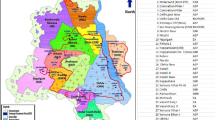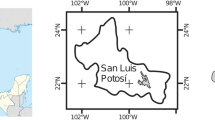Abstract
This study investigates the potential impact of OSPW (oil sands processed water) in terms of naphthenic acids (NAs) in the event that OSPW which contain NAs were discharged to a stretch of the Athabasca River of Alberta, Canada. A one-dimensional model WASP7 (water quality analysis simulation programme) was hydro-dynamically calibrated and validated for the data 1999–2008. The model represented the field data quite well except frozen seasons. The sensitivity analysis showed that the concentrations of NAs in the Athabasca River due to OSPW discharged to the river will be most sensitive to changes in the discharge rate of OSPW and concentrations of NAs in the OSPW. The WASP7 was applied to investigate how to achieve acceptable concentrations of NAs (≤0.15 mg/L) along the river, assuming NAs are degraded by natural dilution, biodegradation, sorption, photodegradation or combinations of these processes. If only the dilution effect is considered for an OSPW discharged at 1.5, 3.0 and 4.5 m3/s (initial NAs concentration of 120 mg/L) to the river, respectively, all the NAs concentrations simulated would exceed an allowable limit of ≤0.15 mg/L, which indicates that dilution effect alone is not sufficient to decrease the concentration of NAs in the river. Similarly, by only considering a photodegradation rate of 0.005/day, the concentrations of NAs would decrease by approximately 0.1–3 %. However, by only considering a maximum biodegradation rate of 0.4/day, NAs discharged to the river can be decreased by 5–90 %. If a more moderate biodegradation rate of 0.2/day is assumed but photodegradation is also considered at 0.0025/day, then for the same three discharge rates of OSPW to the river, the allowable OSPW NAs have to be limited to 8.02, 4.09 and 2.77 mg/L to limit NAs at 0.15 mg/L. This implies that high biodegradation itself is more effective than a combination of moderate biodegradation and photodegradation in degrading NAs. Through multiple numerical experiments with WASP7, it seems that to limit the concentrations of the final NAs in the Athabasca River within 0.15 mg/L, it will be crucial to limit the OSPW NAs and the OSPW discharge rate to the river.








Similar content being viewed by others
References
Alberta Energy and Utilities Board. (2005). Alberta’s reserves 2004 and supply/demand outlook 2005-2014. Calgary, Alberta, Canada. http://www.aer.ca/documents/sts/ST98/ST98-2005.pdf. Accessed 23 Apr 2010.
Alberta Energy and Utilities Board. (2007). Alberta Ministry of Energy. Annual Report 2006-2007. http://www.energy.gov.ab.ca//Org/Publications/AR2007.pdf. Accessed 23 April 2010.
Ambrose, R. B., Martin, J. L. & Wool, T. A. (2006). WASP7 Benthic algae—model theory and user's guide. No. EPA/600/R-06/106 (NTIS PB2007-100139). www.epa.gov. Accessed 23 Apr 2010.
Ambrose, R. B. & Wool, T. A. (2009). WASP7 stream transport model theory and user's guide. Environmental Protection Agency (EPA). www.epa.gov/athens. Accessed 23 Apr 2010.
Beltaos, S. (1982). 'Notes on ice hydraulics'—hydraulics of ice-covered rivers and ice-jam analysis. Hull, Quebec. Burlington: National Water Research Institute Report.
Beltaos, S. (1983). River ice jams—theory, case studies, and applications'. Journal of Hydraulic Engineering ASCE, 109, 1338–1359.
Beltaos, S., & Prowse, T. D. (2001). Climate impacts on extreme ice-jam events in Canadian rivers. Hydrological Science Journal, 46, 157–181.
Chapra, S. (1997). Surface water-quality modeling. New York: McGraw-Hill.
Chow, V. T. (1981). Open channel hydraulic: international student edition. New York: McGraw-Hill.
Clemente, J. S., & Fedorak, P. M. (2005). A review of the occurrence, analyses, toxicity, and biodegradation of naphthenic acids. Chemosphere, 60, 585–600.
Deksissa, T. (2004). Dynamic integrated modelling of basic water quality and fate and effect of organic contaminants in rivers. Ph.D Degree, Applied Biological Sciences: Environmental Technology, University of Gent, 306 pp.
Dokholyan, B. K., & Magomedov, A. K. (1984). The effect of sodium naphthenate on the viability and physiological and biochemical indices of fish. Voprosy Ikhtiologii, 23, 1013–1019.
Drzewicz, P., Atefeh, A., Mohamed, G. E., & Martin, J. W. (2010). Degradation of a model naphthenic acid, cyclohexanoic acid, by vacuum UV (172 nm) and UV (254 nm)/H2O2. Journal of Physical Chemistry A, 114, 12067–12074.
Eckert, W. F., Masliyah, J. H., Gray, M. R., & Fedorak, P. M. (1996). Prediction of sedimentation and consolidation of fine tails. AIChE Journal, 42, 960–972.
Einstein, N. (2006). Wikimedia Commons. <http://commons.wikimedia.org/wiki/File:Athabasca_Oil_Sanda_map.png>. Accessed 10 August 2011
Frank, R. A., Fischer, K., Kavanagh, R., Burnison, B. K., Arsenault, G., Headley, J. V., Peru, K. M., Van der Kraak, G., & Solomon, K. R. (2009). Effect of carboxylic acid content on the acute toxicity of oil sands naphthenic acids. Environmental Science and Technology, 43, 266–271.
Han, X. M., Scott, A. C., Fedorak, P. M., Bataineh, M., & Martin, J. W. (2008). Influence of molecular structure on the biodegradability of naphthenic acids. Environmental Science and Technology, 42, 1290–1295.
He, Y. H., Wiseman, S. B., Zhang, X. W., Hecker, M., Jones, P. D., El-Din, M. G., Martin, J. W., & Giesy, J. P. (2010). Ozonation attenuates the steroidogenic disruptive effects of sediment free oil sands process water in the H295R cell line. Chemosphere, 80, 578–584.
Headley, J. V., Tanapat, S., Putz, G., & Perut, K. M. (2002). Biodegradation kinetics of geometric isomers of model naphthenic acids in Athabasca River water. Canadian Water Resources Journal, 27(1), 25–42.
Headley, J. V., Du, J. L., Peru, K. M., & McMartin, D. W. (2010). Mass spectrometry of the photolysis of sulfonylurea herbicides in prairie waters. Mass Spectrometry Reviews, 29, 593–605.
Headley, J. V., & McMartin, D. W. (2004). A review of the occurrence and fate of naphthenic acids in aquatic environments. Journal of Environmental Science Health Part A, 39, 1989–2010.
Herman, D. C., Fedorak, P. M., & Costerton, J. W. (1993). Biodegradation of cycloalkane carboxylic-acids in soil sand tailings. Canadian Journal of Microbiology, 39, 576–580.
Herman, D. C., Fedorak, P. M., Mackinnon, M. D., & Costerton, J. W. (1994). Biodegradation of microbial acids by microbial-populations indigenous to oil sands tailings. Canadian Journal of Microbiology, 40, 467–477.
Hilal, S. H. (2006). Estimation of hydrolysis rate constants of carboxylic acid ester and phosphate ester compounds in aqueous systems from molecular structure by SPARC. Washington DC: Environmental Protection Agency.
Holowenko, F. M., MacKinnon, M. D., & Fedorak, P. M. (2002). Characterization of naphthenic acids in oil sands wastewaters by gas chromatography–mass spectrometry. Water Research, 36, 2843–2855.
Janfada, A., Headley, J. V., Peru, K. M., & Barbour, S. L. (2006). A laboratory evaluation of the sorption of oil sands naphthenic acids on organic rich soils. Journal of Environmental Science Health Part A, 41, 985–997.
Kannel, P. R., & Gan, T. (2012). Naphthenic acids degradation and toxicity mitigation tailings wastewater systems and aquatic environments: a review. Journal of Environmental Science Health Part A, 47, 1–21.
Karickhoff, D. S., Brown, D. S. A., & Scott, T. A. (1979). Sorption of hydrophobic pollutants on natural sediments. Water Research, 13, 241–248.
Kellerhals, R., Neill, C. R., & Brag, D. J. (1972). Hydraulic and geomorphic characteristics of rivers in Alberta. Edmonton: Research Council of Alberta.
Kim, D., Wang, Q. R., Sorial, G. A., Dionysiou, D. D., & Timberlake, D. (2004). A model approach for evaluating effects of remedial actions on mercury speciation and transport in a lake system. The Science of the Total Environment, 327, 1–15.
Lohman, K., Pai, P., Seigneur, C., & Levin, L. (2000). Sensitivity analysis of mercury human exposure. The Science of the Total Environment, 259, 3–11.
MacKinnon, M. D. (1989). Development of the tailings pond at Syncrude' s oil sands plant: 1978–1987. AOSTRA Journal of Research, 5, 109–134.
Martin, J. W., Barri, T., Han, X. M., Fedorak, P. M., El-Din, M. G., Perez, L., Scott, A. C., & Jiang, J. T. (2010). Ozonation of oil sands process-affected water accelerates microbial bioremediation. Environmental Science and Technology, 44, 8350–8356.
McMartin, D. W., Headley, J. V., Friesen, D. A., Peru, K. M., & Gillies, J. A. (2004). Photolysis of naphthenic acids in natural surface water. Journal of Environmental Science Health Part A, 39, 1361–1383.
Mishra, S., Meda, V., Dalai, A. K., McMartin, D. W., Headley, J. V., & Peru, K. M. (2010). Photocatalysis of naphthenic acids in water. Journal Water Resource Protection, 2, 644–650.
Morgan, M. G., & Henrion, M. (1990). Uncertainty—a guide to dealing with uncertainty in quantitative risk and policy analysis. Cambridge: Cambridge University Press.
Peng, J., Headley, J. V., & Barbour, S. L. (2002). Adsorption of single-ring model naphthenic acids on soils. Canadian Geotechnical Journal, 39, 1419–1426.
Prowse, T. D., & Beltaos, S. (2002). Climatic control of river-ice hydrology: a review. Hydrological Processes, 16, 805–822.
Rogers, V. V., Liber, K., & MacKinnon, M. D. (2002a). Isolation and characterization of naphthenic acids from Athabasca oil sands tailings pond water. Chemosphere, 48, 519–527.
Rogers, V. V., Wicklstorm, M., Liber, K., & MacKinnon, M. D. (2002b). Acute and subchronic mammalian toxicity of Naphthenic acids from oil sands tailings. Isolation and characterization of naphthenic acids from Athabasca oil sands tailings pond water. Toxicol Science, 66, 347–355.
Schramm, L. L., Stasiuk, E. N., & MacKinnon, M. (2000). Surfactants in Athabasca oil sands slurry conditioning, flotation recovery, and tailings processes. In L. L. Schramm (Ed.), Surfactants, fundamentals and applications in the petroleum industry (pp. 365–430). Cambridge: Cambridge University Press.
Scott, A. C., MacKinnon, M. D., & Fedorak, P. M. (2005). Naphthenic acids in Athabasca oil sands tailings waters are less biodegradable than commercial naphthenic acids. Environmental Science and Technology, 39, 8388–8394.
Scott, A. C., Zubot, W., MacKinnon, M. D., Smith, D. W., & Fedorak, P. M. (2008). Ozonation of oil sands process water removes naphthenic acids and toxicity. Chemosphere, 71(1), 156–160.
Suncor Energy Inc. (2010). Suncor's 2010 report on sustainability. Canada: Edmonton. http://sustainability.suncor.com/2010/default.aspx. Accessed 7 Mar 2011.
Syncrude Canada Limited. (2009). 2008/2009 sustainability report. http://www.syncrude.ca/pdf/Syncrude-SD-report.pdf. Accessed 7 March 2011
Tanapat. (2001). Comparison of biodegradation kinetics of geometrics isomers of naphthenic acids (NAs) in Athabasca river water. MSC thesis; University of Saskatchewan, Saskatoon, Saskatchewan. pp. 100.
Tetratech. (2009). Hydrodynamic and water quality model of the lower Athabasca River, draft report (unpublished) (p. 79). Virginia: Fairfax.
Whitby, C. (2010). Microbial naphthenic acid degradation. In I. L. Allen, S. Sima, & M. G. Geoffrey (Eds.), Advances in applied microbiology, vol. 70 (pp. 93–125). San Diego: Academic Press.
Wool, T. A., Ambrose, R. B., Martin, J. L., & Comer, E. A. (2001). Water quality analysis simulation program (WASP) version 6.0: Users Manual. Athens: Environmental Protection Agency.
Young, R. F., Wismer, W. V., & Fedorak, P. M. (2008). Estimating naphthenic acids concentrations in laboratory-exposed fish and in fish from the wild. Chemosphere, 73, 498–505.
Acknowledgements
The first author was supported by a research grant provided by the Alberta Water Research Institute of Canada. The University of Alberta gratefully acknowledges the support of Alberta Environment and Protection for providing the climate and flow data used in this study.
Author information
Authors and Affiliations
Corresponding author
Rights and permissions
About this article
Cite this article
Kannel, P.R., Gan, T.Y. Application of WASP for Modelling and Management of Naphthenic Acids along Athabasca River, Alberta, Canada. Water Air Soil Pollut 224, 1764 (2013). https://doi.org/10.1007/s11270-013-1764-1
Received:
Accepted:
Published:
DOI: https://doi.org/10.1007/s11270-013-1764-1




